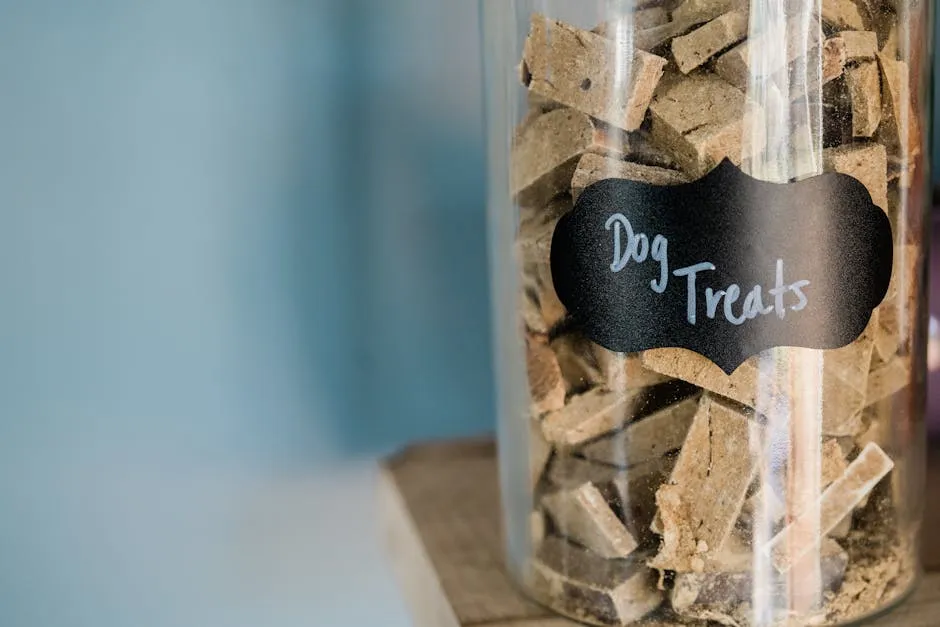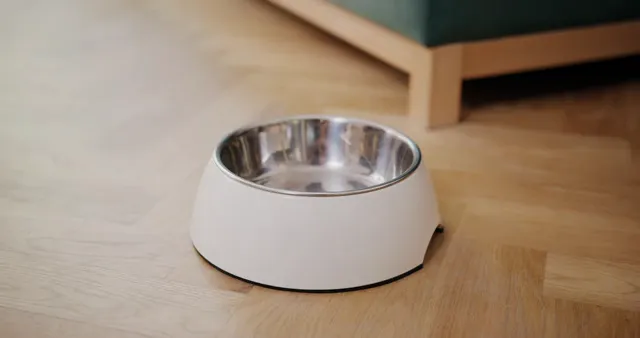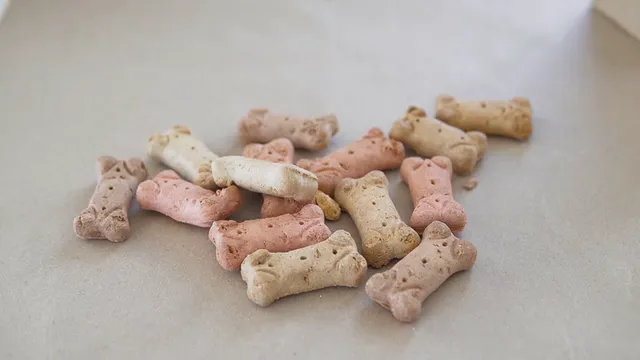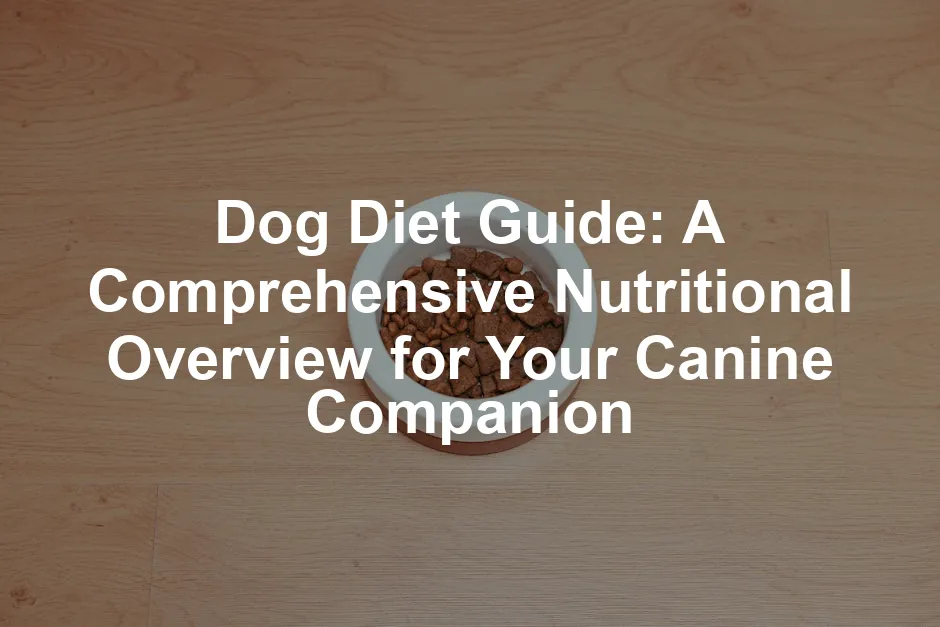Introduction
A balanced diet is key for your dog’s health. Proper nutrition helps prevent many health issues. However, choosing the right food can be overwhelming for pet owners. This guide aims to clarify dog nutrition and help you understand what your dog needs.
Summary and Overview
A dog’s diet should include proteins, fats, carbohydrates, vitamins, and minerals. Proteins are essential for growth and repair, while fats provide energy and support skin health. Carbohydrates offer dietary fiber and energy, and vitamins and minerals are crucial for overall health.
Every dog is unique, so consider factors like age, breed, and health when choosing food. Puppies need different nutrients than adult or senior dogs. This guide will walk you through dog nutrition, food types, feeding guidelines, and special dietary needs, making it easier for you to provide the best care for your furry friend.

Speaking of care, have you considered how to keep your dog’s food fresh and organized? Investing in a Dog Food Storage Container can keep your dog’s kibble fresh and tasty, free from pesky pests. Plus, it adds a dash of organization to your pet pantry!
Understanding Dog Nutrition
Are Dogs Carnivores, Herbivores, or Omnivores?
Dogs are classified as omnivores. This means they can eat both animal and plant foods. Their ancestors primarily ate meat, but they adapted over time. This evolution allows them to thrive on a mixed diet. You might wonder why this matters for your dog’s diet. Since dogs can digest a variety of foods, it opens up many dietary options. You can include fruits, vegetables, and grains alongside meats. This flexibility can help you tailor their meals based on preferences and nutritional needs. Always aim for balance to ensure your dog stays healthy and happy.
Essential Nutritional Components
To keep your dog healthy, focus on six essential nutrients: water, proteins, fats, carbohydrates, vitamins, and minerals.
- Water: Vital for hydration, digestion, and temperature regulation. Always provide fresh water.
- Proteins: Crucial for growth, tissue repair, and energy. Quality sources include meat, fish, and eggs.
- Fats: Necessary for energy, skin health, and vitamin absorption. Look for healthy fats like omega-3 and omega-6.
- Carbohydrates: Provide energy and support digestive health. Sources include grains, vegetables, and fruits.
- Vitamins: Essential for various bodily functions. Ensure a mix of fat-soluble and water-soluble vitamins.
- Minerals: Important for bone health and metabolic processes. Include calcium, phosphorus, and trace minerals in their diet.

Each nutrient plays a unique role in your dog’s overall well-being. Prioritizing a balanced diet ensures they get what they need for a healthy, active life.
And while we’re on the topic of keeping your furry friend healthy, don’t forget about their joints! If your pup is getting older or has been a bit too enthusiastic in their play, consider adding Dog Supplements for Joint Health to their regimen. These can help keep their joints limber and reduce any discomfort they may be experiencing.
Choosing the Right Dog Food
Types of Dog Food
When selecting food for your dog, consider the four main types: dry, wet, raw, and homemade.
- Dry Food: Often called kibble, dry food is convenient and helps maintain dental health. It usually contains balanced nutrients. However, some dogs may find it less palatable. best dry dog food
- Wet Food: Canned food is often more appealing to dogs. It’s hydrating and easy to chew. The downside is that it can be pricier and may lead to dental issues if not balanced with dry food. wet dog food
- Raw Food: A raw diet mimics what dogs ate in the wild. It’s rich in nutrients and can improve coat health. However, it requires careful preparation to avoid contamination and nutritional imbalances. Consider starting with a Raw Dog Food Starter Kit to ease into this method.
- Homemade Food: Preparing food at home allows you to control the ingredients. It can be healthier but may lack essential nutrients without proper knowledge. healthy homemade dog food recipes for senior dogs

Each type has its pros and cons. Choosing the right one depends on your dog’s needs, preferences, and your lifestyle.
And for those who love a good culinary adventure, why not explore a Homemade Dog Treat Recipe Book? You can whip up delicious and healthy snacks that your dog will drool over!
Reading Dog Food Labels
Understanding dog food labels is crucial for making informed choices. Start by checking the ingredient list. Ingredients are listed by weight, so the first few should be high-quality proteins. Look for specific meats rather than vague terms like “meat meal.”
Next, examine the guaranteed analysis, which shows the minimum percentages of protein, fat, and fiber. This helps you assess nutritional content.
Quality ingredients are essential. Look for products with the Association of American Feed Control Officials (AAFCO) statement. This indicates that the food meets recognized nutritional standards.
Finally, consider the feeding guidelines. They provide a general idea of how much to feed based on your dog’s weight and activity level. Always consult your veterinarian for personalized advice on choosing the best food.

Special Dietary Needs
Every dog has unique dietary requirements based on age, activity level, and health conditions. Puppies need higher protein and calorie content to support their growth. Adult dogs require balanced nutrients for maintenance, while senior dogs benefit from lower calories and joint support.
Certain health issues may necessitate special diets. For instance, dogs with allergies might need a limited-ingredient diet. Obesity calls for calorie-controlled meals. If your dog has a medical condition, consult your veterinarian for tailored dietary recommendations. They can help create a plan that meets your dog’s specific needs and promotes overall health.
And while you’re at it, don’t forget to keep your pup’s dental health in check! A good Dog Toothbrush and Toothpaste can help keep those pearly whites shining and prevent any dental issues down the road!
Feeding Guidelines
How Much to Feed
Determining the right portion size for your dog is crucial. Start by considering your dog’s weight, age, and activity level. A general rule is to feed about 2-3% of their body weight daily. For example, a 50-pound dog might need around 1-1.5 pounds of food each day.
Puppies require more energy and nutrients for growth, so they need larger portions relative to their size. Adult dogs typically need fewer calories, while senior dogs may need even less due to decreased activity.
It’s essential to monitor your dog’s body condition. You should be able to feel their ribs without excess fat covering. If your dog becomes overweight, reduce their food intake gradually. Conversely, if they seem underweight, consider increasing their portions. Regular vet check-ups can help you maintain a healthy weight for your furry friend.

And while you’re keeping track of their diet, a Dog Crate for Training can be a great tool for establishing a safe space for your dog while also assisting with house training.
Feeding Frequency
Feeding frequency varies based on your dog’s life stage. Puppies usually need four meals a day until they are about six months old. Once they reach this age, you can reduce their meals to two or three daily.
For adult dogs, two meals per day is common. This schedule helps prevent bloating, especially in deep-chested breeds. Some owners prefer free feeding, where food is available all day. While this can work for some dogs, it may lead to overeating. Always measure out the daily portion to avoid excess.

Treats and Snacks
Choosing Healthy Treats
Treats play a vital role in your dog’s diet. They are not just tasty rewards; they can also aid in training and strengthen your bond. However, moderation is key. Treats should make up no more than 10% of your dog’s daily calories. Look for healthy options, like small pieces of carrot, apple slices, or commercial treats with natural ingredients. When rewarding your dog, keep the portions small to avoid excess calories. Remember, a little can go a long way in showing your love! how to prepare homemade frozen dog treats for summer

And if you’re looking for a fun way to keep your pup entertained while rewarding them, consider a Dog Treat Dispenser Ball. It’s a great way to combine playtime with snack time!
Foods to Avoid
Some human foods can be extremely harmful to dogs. Always avoid giving them chocolate, grapes, raisins, onions, and garlic, as these can be toxic. Foods like avocados and nuts can also pose risks. Harmful ingredients can lead to severe health issues, including kidney failure or gastrointestinal distress. Always be cautious and consult your vet if you’re unsure about a specific food. Keeping your dog safe means keeping these dangerous treats out of reach.

Conclusion
A balanced diet is crucial for your dog’s health and happiness. Each dog has unique needs, so consider their age, size, and activity level when choosing food. Regular consultation with your veterinarian will ensure your dog receives tailored dietary advice. Proper nutrition leads to a healthier, happier life and can significantly increase your dog’s longevity. Make informed choices, and enjoy many years with your furry friend!
And don’t forget, a little pampering goes a long way! Consider treating your dog to a Dog Grooming Kit for those at-home spa days!
Please let us know what you think about our content by leaving a comment down below!
Thank you for reading till here 🙂
All images from Pexels





